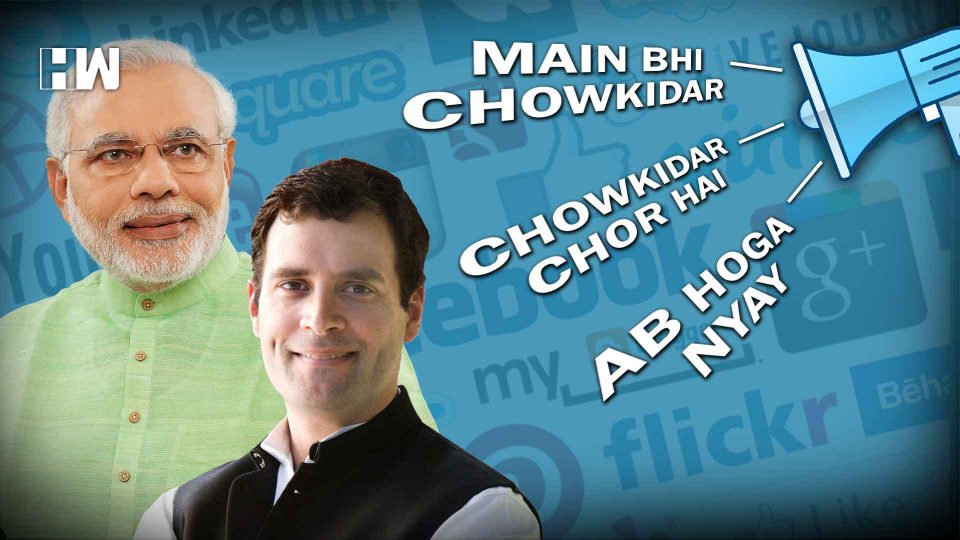“According to the report, the traditional ground campaigning still dominates the outcome of Indian elections, despite the campaigns catching eyeballs online”.
Is it India’s first social media election? That was a question asked by the BBC back in 2014’s general elections. That time the country had just 20 crore people with access to the internet. Such was the engagement of the prime ministerial candidate Narendra Modi on social media platforms that everybody honoured him as a moderniser and a powerful campaigner and was also compared with former US president Barack Obama.
India was once again in the middle of a general election that was held in seven phases dated from 11th of April to 19th of May of 2019. And in the last 5 years, the novelty of social media has now become a natural part of election campaigns with all political parties and leaders marking its presence. India has now 560 million people with access to the internet. It is also the largest market for Facebook and WhatsApp in the world, while Twitter is still treated as one of its crucial and expanding markets.
News reports had also shown huge advertising budgets being earmarked by several political parties for social media. But according to a recent case study by Centre for the Study of Developing Societies survey, shows that the role of social media being “a key influencer” of voting choices in 2019 elections may have been a little exaggerated.
According to the report, the traditional ground campaigning still dominates the outcome of Indian elections, despite the campaigns catching eyeballs online.
The CSDS report titled ‘Political Behaviour and Social Media’ found that the BJP’s vote share lead over the Congress among social media users was actually lower than in 2014. The entire survey is done within a time period of 2017-2019.
In a section of a report that talks about how social media “Is not a platform for political discussions” it says that “though social media is believed to have the capacity to strengthen democracy by providing a new arena for online deliberation on politics, however, this survey does not seem to confirm this line of argument, at least with respect to India. It says that “Despite social media growing at a rapid pace, not many social media users in our survey reported using it for airing their political views and thoughts. Only one in every four users of social media said that they express their personal views on politics either daily or sometimes.
In a survey where the users were asked a question like “How frequently do you undertake the following actions on Twitter or Facebook or WhatsApp – daily, sometimes, rarely or never? where figure (A) shows 5% users never express their personal views on politics. In Figure (B) shows 5% often they Share/forward any political material and in fig (C) shows 12% users read news related to politics on social media.

Therefore the survey, in fact, found that social media users seem to be relatively more comfortable in just being passive recipients of political news on social media rather than actively sharing news. So though there is a tremendous growth of social media users between 2014-2019 elections but the survey shows that this platform was hardly used for airing their respective political views or sharing political content.
This survey even mentioned which caste and communities among total users have used various social networking sites. Among which Muslims stands second only to that of Hindu upper castes, its gender, age in proportion to the actual population.
Although there is a general belief and a strong hunch among many that social media played a major role in the BJP’s return to power, but there hasn’t been much evidence presented to substantiate or refute this line of thinking. The survey did establish a relationship between social media usage and BJP voters, showing that voters with high exposure to social media were most likely to have voted for the saffron party, with the ruling party’s vote share dropping among those with low or no exposure. It notes that 43 percent of those with high exposure voted for the BJP, dropping to 39% among those with moderate exposure, 37% of those with low exposure and 36% of those with no exposure.
In fact, BJP’s social media advantage over its principal rival, Congress, actually declined between 2014 and 2019. In a section titled “BJP’s social media advantage over INC actually declined”.The survey talks about “When we compare the performance of the BJP and the Congress among Twitter and Facebook users in 2019 with their performance among the users of these platforms in 2014, we notice that the greatest gains made by the BJP were among those who did not use these two platforms at all compared to those who did,” it says, adding that among daily Facebook users, the vote share gap fell from 27% in 2014 to 21% points in 2019. And the same goes for Twitter users.
This survey’s findings also put across the point that traditional ground campaigning still dominates the outcome of Indian elections, despite some campaigns doing well online. For example, the narrative of Congress’ “Chowkidar chor hai“ was more popular on social media compared to the BJP’s “Main Bhi Chowkidar” campaign, but, it did not translate into electoral gains for the former. As per the survey, for these 2 slogans, BJP’s Main Bhi Chowkidarhas received 81% of high exposure while Congress’ Chowkidar Chor Hai received 84% of its high exposure.

And if you have a look at the figure, of all the social media platform you’ll find that the number of Congress’ slogan is competitively higher than BJP’s with FB 82, Twitter 80, Whatsapp 87, Instagram 83 and Youtube have 82.

Whereas BJP’s Chowkidar chor hai got FB 79, Twitter 77, Whatsapp has 78, Instagram has 81 and Youtube got 79. So basically, people have heard Chowkidar chor hai more than Modi’s main bhi chowkidar slogan.

The survey also talks about Congress’ main electoral promise, the Nyunatam Aay Yojana, or NYAY, which aimed to provide minimum income support.
According to the survey, it can be said that Congress did manage to communicate about the scheme to about three-fourth of the users having high/moderate exposure to social media with the respondents having low exposure not far behind, but it failed to reach out to half of the nonusers of social media platforms. So according to the figure, social media users heard of NYAY scheme with high exposure is 77% and no exposure is 49% respectively.

Moving on, the survey also talked about user’s trust on social media as well.. During the last few years, we have witnessed a significant increase in ‘fake news’, consisting of deliberate misinformation spread via social media. This phenomenon was even more common at the time of elections.. to spread, or to instigate its supporters to spread a lot of misinformation and mislead the voters. Now in order to have a better picture, they have done a survey how much trust do they have in the news that is shared on various social media platforms too. The survey also says that almost one in every four respondents, irrespective of their usage patterns, had claimed to have no trust at all on the news shared across various social media platforms.
As the survey data indicates, social media did play an important role in carrying forward the message regarding political slogans, proposed schemes of the parties and actions taken by the security forces and etc..But there is certainly a gap between digital ‘haves’ and ‘have-nots’ that needs greater attention as far as internet society is concerned.
Dear Readers,
As an independent media platform, we do not take advertisements from governments and corporate houses. It is you, our readers, who have supported us on our journey to do honest and unbiased journalism. Please contribute, so that we can continue to do the same in future.
As an independent media platform, we do not take advertisements from governments and corporate houses. It is you, our readers, who have supported us on our journey to do honest and unbiased journalism. Please contribute, so that we can continue to do the same in future.

